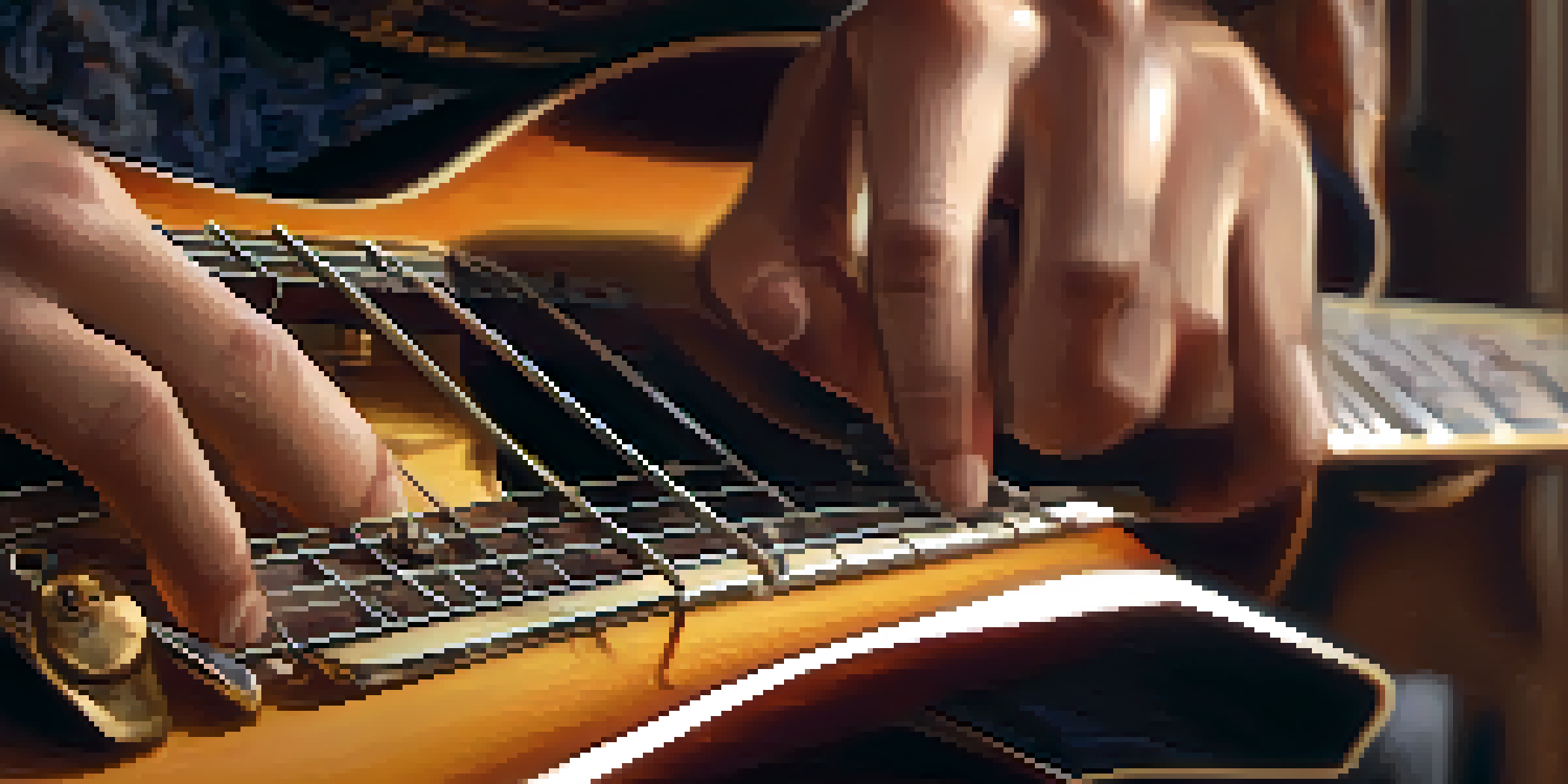Mastering Bending Techniques for Expressive Guitar Solos

Understanding Guitar Bending: The Basics
Bending is a technique where you push or pull a string to raise its pitch, creating a more expressive sound. It’s a crucial skill for guitarists looking to add emotion to their solos. By mastering this technique, you can convey feelings that notes alone might not express.
The guitar is a miniature orchestra in itself.
Think of bending like a singer hitting a high note. It adds a level of intensity and emotion that can turn a simple melody into something profound. Understanding the basics sets the foundation for more advanced techniques and styles across different genres.
In this section, we'll explore how to practice basic bends and the importance of finger strength and control. With consistent practice, you'll find bending becomes an intuitive part of your playing.
Types of Bends: Half and Whole Bends Explained
There are two primary types of bends: half bends and whole bends. A half bend raises the pitch by a half step, while a whole bend raises it by a full step. Each type can evoke different emotions and fits various musical contexts, making them essential tools in your playing arsenal.

For example, a half bend can create a subtle, sweet sound, perfect for blues and rock, while a whole bend delivers a more dramatic effect, often used in solos for a passionate climax. Understanding when to use each type can significantly impact your expressiveness on the guitar.
Mastering Guitar Bending Basics
Bending is a vital technique that allows guitarists to express emotions in their playing by raising the pitch of notes.
In this section, we’ll provide exercises to help you distinguish between half and whole bends, ensuring you can switch between them seamlessly in your solos.
Bending Techniques: Using Your Fingers Wisely
Your fingers are your best friends when it comes to bending. Using the right fingers can drastically improve your control and accuracy. Typically, the third finger (ring finger) is used for bending, while the first (index) and second (middle) fingers act as support.
Music can change the world because it can change people.
Imagine your fingers working together like a team in a tug-of-war. The supporting fingers stabilize the string while the bending finger does the heavy lifting. This teamwork allows for smoother bends and more expressive playing.
In this section, we’ll discuss finger positioning and how to build strength and dexterity in your bending fingers for improved performance.
Bending with Vibrato: Adding Flair to Your Sound
Adding vibrato to your bends can elevate your playing to new heights. Vibrato is the slight oscillation of pitch that enhances the emotional quality of a note. When combined with bending, it creates a rich, singing quality that captivates your audience.
Think of vibrato as the icing on the cake. It’s not just about hitting the right notes but about how you deliver them. When you bend a note and add vibrato, you're inviting the listener into your musical story.
Types of Bends: Half and Whole
Understanding half and whole bends is essential, as each type evokes different emotions and fits various musical contexts.
In this section, we’ll cover techniques for incorporating vibrato into your bends, ensuring your solos are as expressive as your musical ideas.
Advanced Bending Techniques: Pre-bends and Release Bends
Once you've mastered the basics, it's time to explore advanced bending techniques like pre-bends and release bends. A pre-bend occurs when you bend a note before plucking it, creating a unique sound that catches listeners off guard.
On the other hand, a release bend involves bending a note and then letting it drop back to its original pitch. This technique can create a sense of resolution that beautifully resolves melodic ideas. Both techniques add depth to your playing.
In this section, we’ll provide exercises to practice these advanced techniques, allowing you to bring new elements into your solos.
Bending in Different Genres: Adapting Your Style
Bending techniques vary across musical genres, each bringing its flavor to the guitar. In blues, bends are often used to mimic the human voice, while in rock, they can create dramatic peaks within solos. Understanding the nuances of bending in different genres can enhance your versatility as a guitarist.
For instance, country guitar often incorporates quick bends that add a playful feel, while jazz bends are more subtle and sophisticated. By adapting your bending techniques, you can become a more well-rounded musician.
Advanced Bending Techniques
Techniques like pre-bends and release bends add depth and unique sounds to your guitar solos, enhancing your musical expression.
In this section, we’ll explore how to tailor your bending techniques for various genres, helping you find your unique voice within each style.
Practical Exercises: Building Your Bending Skills
Now that you understand the theory behind bending techniques, it's time to put that knowledge into practice. Regular exercises focusing on bending will help develop your finger strength and precision. Simple exercises, like bending a note and returning to its original pitch repeatedly, can work wonders.
Incorporating bends into scales and licks is another great way to practice. By playing scales with intentional bends, you’ll begin to integrate the technique into your muscle memory, making it a natural part of your playing.

In this section, we’ll provide a variety of practical exercises to help you build your bending skills and incorporate them into your playing style.